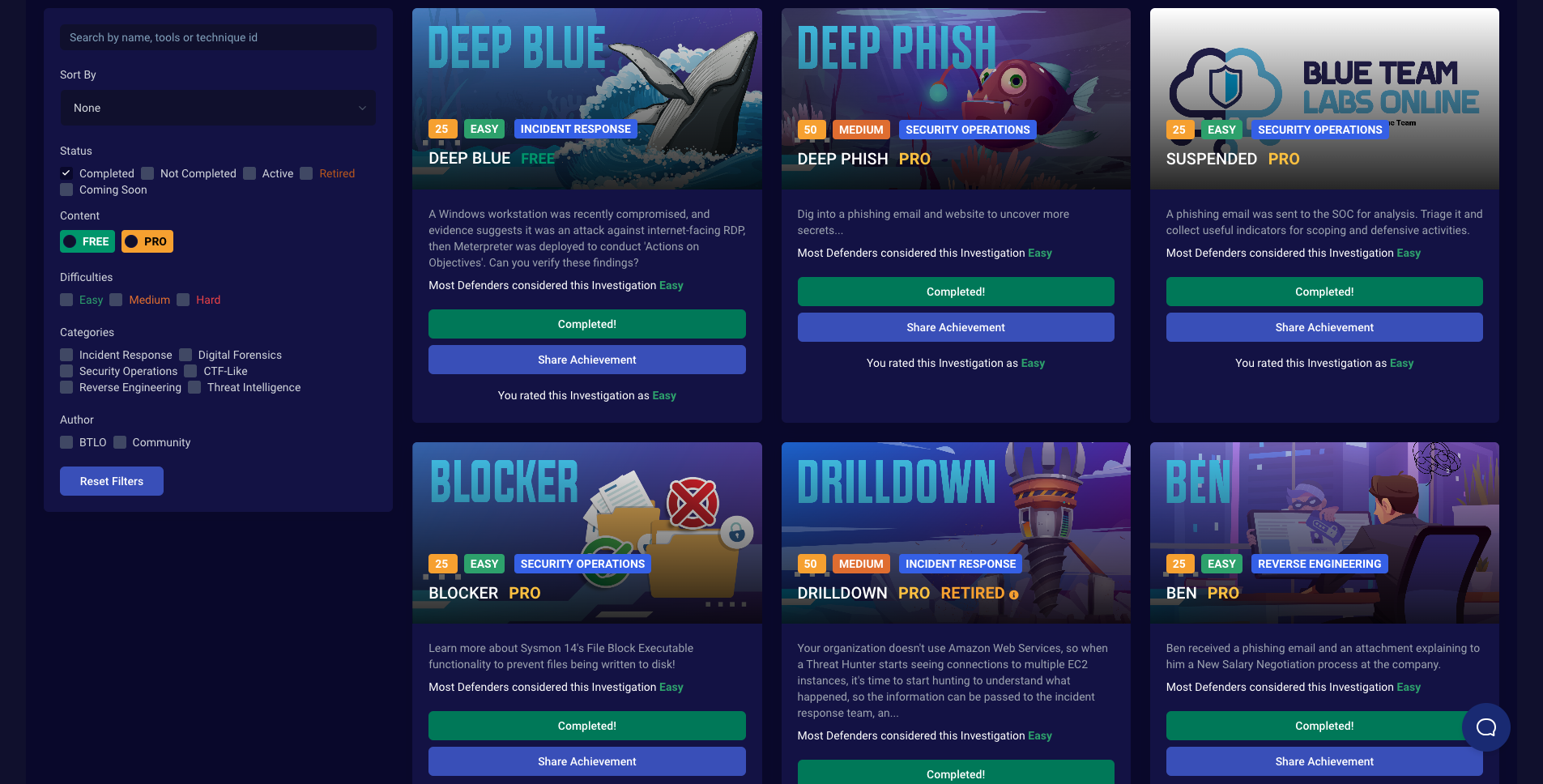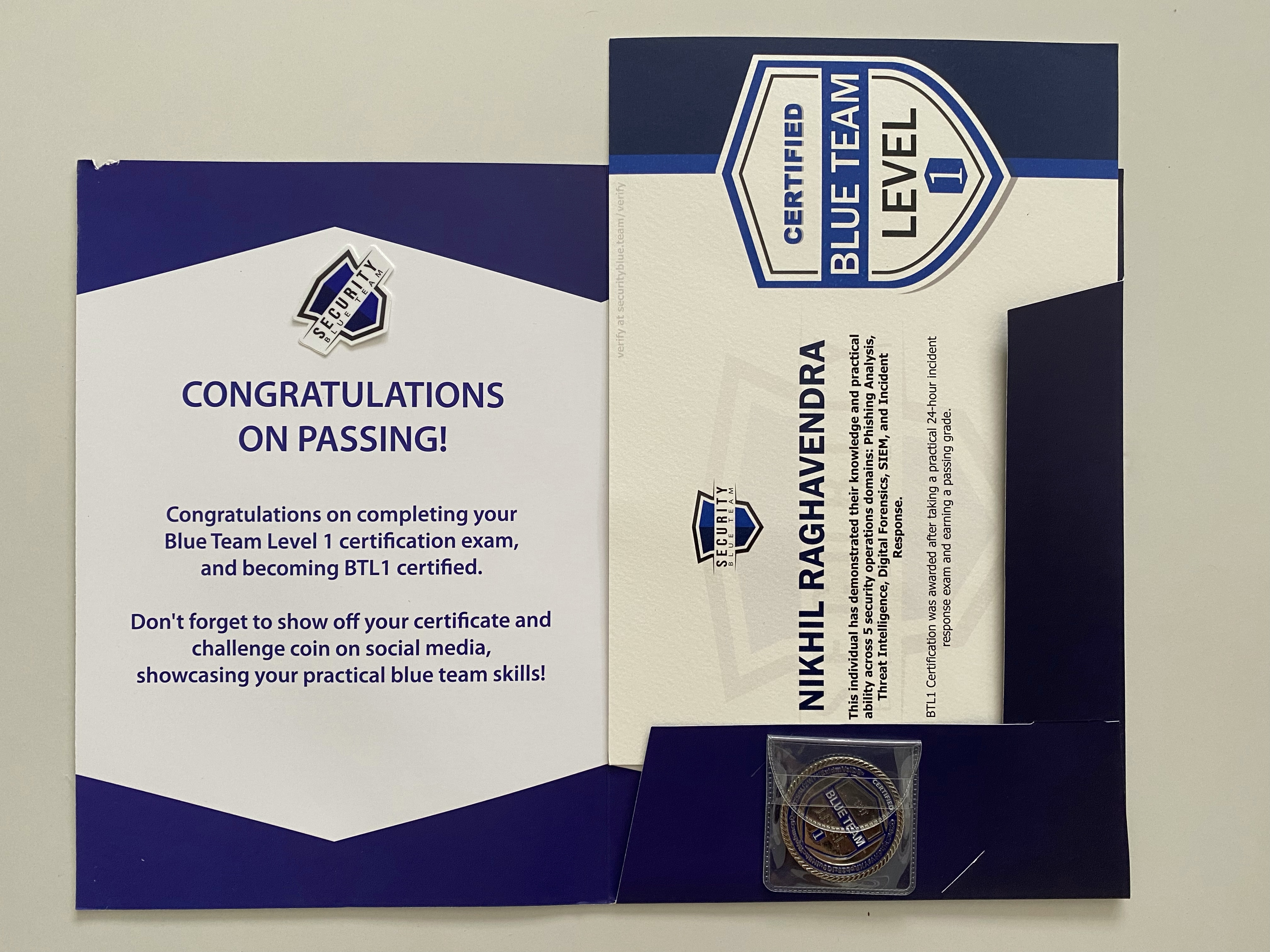[Mailbox] The Blue Team Level 1 Certificate
As the sun cast its early morning glow through my window, a sense of anticipation washed over me. Today wasn’t just another ordinary day—it marked a pivotal moment in my cybersecurity journey. There, nestled among the usual pile of mail, lay the tangible testament to my dedication and skill: the Blue Team Level 1 certificate. The sight of it brought a surge of pride and a flood of memories from the intense 24-hour incident response exam that it represented.
In this blog post, I’m thrilled to not only unveil my freshly minted certification but also to take you behind the scenes of my preparation journey. The Blue Team Level 1 certification is more than just a credential; it’s a rite of passage for aspiring cybersecurity professionals. It tests not only your technical acumen but also your resilience and strategic thinking under pressure. Join me as I unravel the story of how I tackled the grueling 24-hour exam, the strategies I employed, and the invaluable lessons I learned along the way. Whether you’re a fellow cybersecurity enthusiast, pondering over taking the plunge into the world of Blue Team, or simply curious about what it takes to excel in this demanding field, this post is for you. Let’s dive into the realm where skill meets persistence, and discover what it truly takes to earn the Blue Team Level 1 certificate.
About the Blue Team Level 1 Certification
In the ever-evolving domain of cybersecurity, the Blue Team Level 1 (BTL1) Certification emerges as a beacon of excellence for Junior Security Operations. Since its inception in 2020, BTL1 has earned its stripes as a globally revered credential, empowering thousands of technical defenders across a spectrum of critical sectors. From government bodies, CERTs, and law enforcement to military units, MSSPs, financial institutions, and critical national infrastructure, the BTL1 stands as a trusted bastion in the technical defense of digital realms.
A Panoramic View of Cyber Defense Expertise
The BTL1 curriculum is a meticulously crafted journey across six fundamental domains, each designed to fortify your cyber defense arsenal:
- Security Fundamentals: A solid foundation that sets the stage for advanced learning.
- Phishing Analysis: Master the art of identifying and neutralizing phishing threats.
- Threat Intelligence: Hone the skill of predicting and mitigating potential threats.
- Digital Forensics: Dive deep into the digital crime scene to uncover and analyze evidence.
- SIEM (Security Information and Event Management): Harness powerful tools to monitor and analyze security events.
- Incident Response: Learn to react swiftly and effectively to mitigate cyber incidents.
Who Stands to Gain from BTL1?
BTL1 is the crucible where technical defenders are forged. It’s an immersive experience designed to cultivate a broad spectrum of skills for defending networks and responding to cyber incidents. As a participant, you’ll embark on a journey of mastering various competencies such as:
- Analyzing and neutralizing phishing attacks.
- Conducting meticulous forensic investigations to extract and scrutinize digital evidence.
- Leveraging SIEM platforms for probing malicious activities.
- Performing comprehensive log and network traffic analysis, including malware detection.
- Engaging in threat actor research, etc.
These skills are not just theoretical; they’re the very tools actively wielded by defenders worldwide, making you a formidable force in various security roles.
Why BTL1 Stands Apart
BTL1 is the ultimate launchpad for security enthusiasts and professionals aiming to refine their practical defensive cyber skills. The course is particularly beneficial for:
- Students and IT Personnel seeking to kickstart their cybersecurity careers.
- Security Analysts looking to deepen their analytical expertise.
- Incident Responders aiming to sharpen their rapid reaction capabilities.
- Threat Intelligence Analysts interested in mastering the art of threat prediction and mitigation.
- Forensics Analysts eager to excel in digital investigation.
The content, while primarily targeting entry-level or junior roles, is robust enough to challenge and validate the skills of even seasoned professionals. Dive into our course syllabus to discern if BTL1 aligns with your career aspirations or team development goals!
Recognition and Relevance
BTL1 doesn’t just meet but exceeds industry standards, satisfying 60% of the 125 requirements under the NICE Cyber Defense Analyst framework. This includes an impressive 67% of both knowledge and ability criteria, making it a highly credible and sought-after certification in the cybersecurity sphere.
Arsenal of Tools
Embarking on the BTL1 journey equips you with proficiency in an extensive array of tools, each serving as a cornerstone in the realm of cyber defense. From Autopsy for forensic analysis to Wireshark for network protocol analysis, along with powerful platforms like Splunk and TheHive5, you’ll gain hands-on experience with tools that are pivotal in real-world cyber defense scenarios. Each tool, whether used for digital forensics, threat detection, or incident response, is a vital piece in the vast jigsaw of cybersecurity. This ensures that you are not just prepared but also versatile in addressing diverse security challenges. Here’s a comprehensive list of all the tools taught in the course: Autopsy, Browser History Capturer, Browser History Viewer, DeepBlueCLI, DomainTools, Event Viewer, FTK Imager, JumpList Explorer, KAPE, Linux CLI, MISP, OpenCTI, PECmd, PhishTool, PowerShell, ProcDump, Scalpel, Sigma, Snort, Splunk, Suricata, TheHive5, URL2PNG, VirusTotal, Volatility, WannaBrowser, Windows File Analyzer, and Wireshark.
About the 24-hour Incident Response Exam
The Blue Team Level 1 (BTL1) Certification goes beyond traditional learning, immersing students in a real-world setting through the rigorous 24-hour Incident Response Exam. This exam is not just a test of knowledge but a practical demonstration of skills in a high-pressure environment. Students can initiate this exam within 12 months of their course purchase, engaging in a 24-hour session in a cloud lab where they face 20 task-based questions. These questions assess their ability to use tools, analyze systems, and understand tactics within the ATT&CK Framework.
After the exam, students receive immediate grading and feedback. A minimum score of 70% earns the silver challenge coin, while a score of 90% or more on the first attempt awards the gold challenge coin. If a student doesn’t pass on the first try, they receive one free resit voucher, valid for 12 months, with a 10-day waiting period to prevent burnout. Additional resit vouchers are available for £100, adhering to the same 10-day waiting period.
The 24-hour Incident Response Exam is more than just a test; it’s a critical step in the journey of becoming a skilled cybersecurity defender, combining knowledge application with endurance and critical thinking.
Preparing for the 24-hour Incident Response Exam
 The Blue Team Labs Online (BTLO) Platform
The Blue Team Labs Online (BTLO) Platform
My journey to acing the 24-hour Incident Response Exam was significantly bolstered by the dynamic and interactive learning environment provided by Blue Team Labs Online (BTLO). BTLO stands out as a gamified platform meticulously designed for defenders aiming to sharpen their skills. It encompasses a diverse array of security investigations and challenges, spanning crucial areas like incident response, digital forensics, security operations, reverse engineering, and threat hunting. The platform’s structure, with its free and paid tiers, makes it accessible and versatile, catering to a wide spectrum of learning needs.
 Time taken to complete each BTLO investigation
Time taken to complete each BTLO investigation
To ensure a well-rounded preparation, I delved into a series of 10 investigation labs on BTLO, each mirroring the comprehensive nature of the six domains covered in the incident response exam. These labs weren’t just exercises; they were immersive scenarios that pushed me to apply my knowledge practically and adapt to various cyber defense situations. The labs I completed were:
- Deep Blue
- Deep Phish
- Suspended
- Blocker
- Drilldown
- Ben
- Multi Stages
- Sam
- Pretium
Each lab was a step forward in my preparation, building not just my knowledge but also my confidence in handling real-world security challenges. Through this strategic and comprehensive approach to lab investigations on BTLO, I was able to equip myself with the necessary skills and mindset to tackle the 24-hour Incident Response Exam successfully.
Attending the 24-hour Incident Response Exam
Embarking on the 24-hour Incident Response Exam is a formidable challenge that demands not just knowledge and skill but also meticulous planning and discipline. Recognizing the inexorable nature of the exam’s timer, I meticulously strategized my approach, segmenting the 24-hour timeframe to incorporate intervals for sanity checks, rest, meals, and sleep. This structured plan was not just about managing time; it was about maintaining mental clarity and resilience throughout the rigorous exam.
As dawn broke on the day of the exam, I found myself seated at my desk, freshly fueled by breakfast and ready to tackle the challenge ahead. It was 9 am when I initiated the exam, diving into the scenario that unfolded on my screen. The exam is inherently scenario-based, making it imperative to comprehend every nuance and intricacy of the given situation. This initial phase of thorough understanding set the tone for the rest of my exam journey.
Contrary to my plan of utilizing the full 24-hour window, my flow and focus propelled me to complete the exam by 6 pm on the same day. However, not one to leave things to chance, I invested an additional hour in a final sanity check, meticulously reviewing my responses before submitting my answers.
Reflections and Revelations
The moment of truth arrived with my score: an impressive 80%. While this marked a significant achievement of answering 16 out of 20 questions correctly, a tinge of ‘what if’ lingered – I was a mere two questions shy of the gold challenge coin. The detailed feedback was enlightening; it revealed a pivotal oversight – the incorrect application of a filter in Splunk, leading to erroneous answers for two crucial questions. This introspection was not just about pinpointing mistakes but about learning and evolving.
 My Blue Team Level 1 Certificate and the BTL1 Silver Challenge Coin
My Blue Team Level 1 Certificate and the BTL1 Silver Challenge Coin
Reflecting on the journey, the BTL1 certification transcended being a mere credential; it was a transformative experience that marked my foray into the cybersecurity domain. The journey doesn’t end here. Driven by an insatiable quest for knowledge, I’m now navigating the path toward the Certified SCADA Security Engineer certification, under the tutelage of White Hat Hacker and the esteemed Master OccupyTheWeb. As I delve deeper into the cybersecurity abyss, stay tuned for my upcoming blog post detailing this new chapter of my learning odyssey.